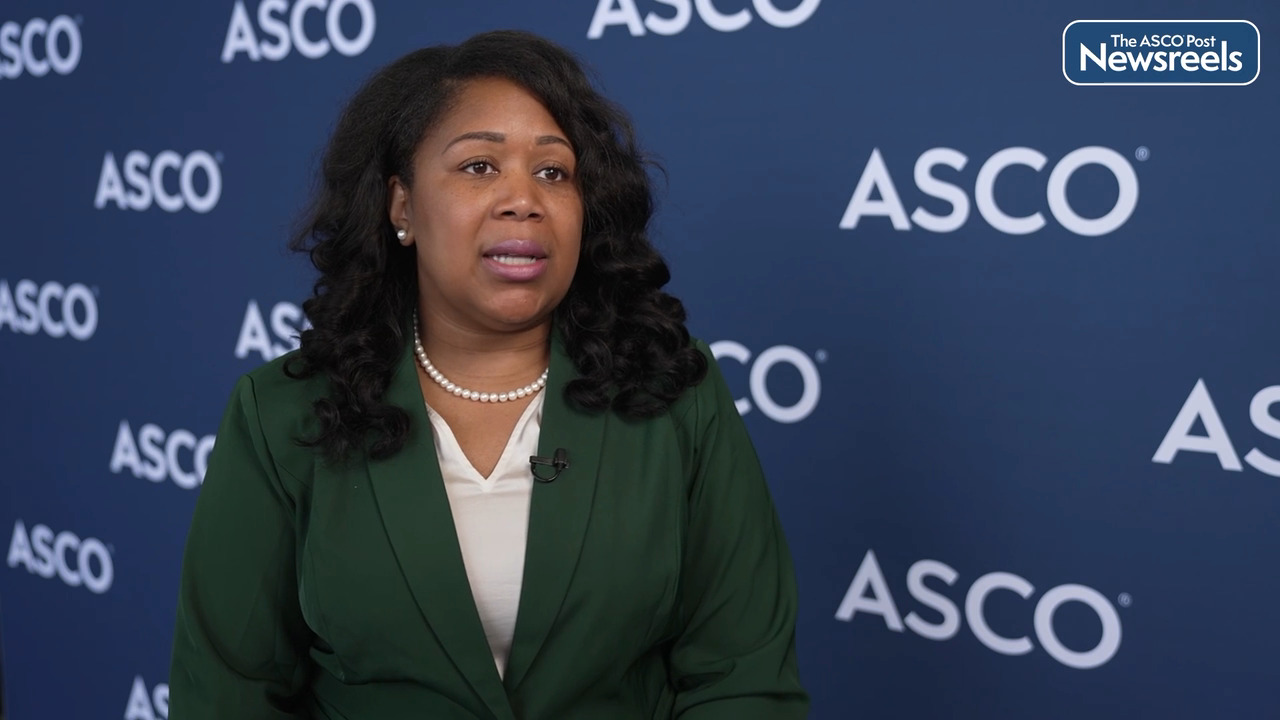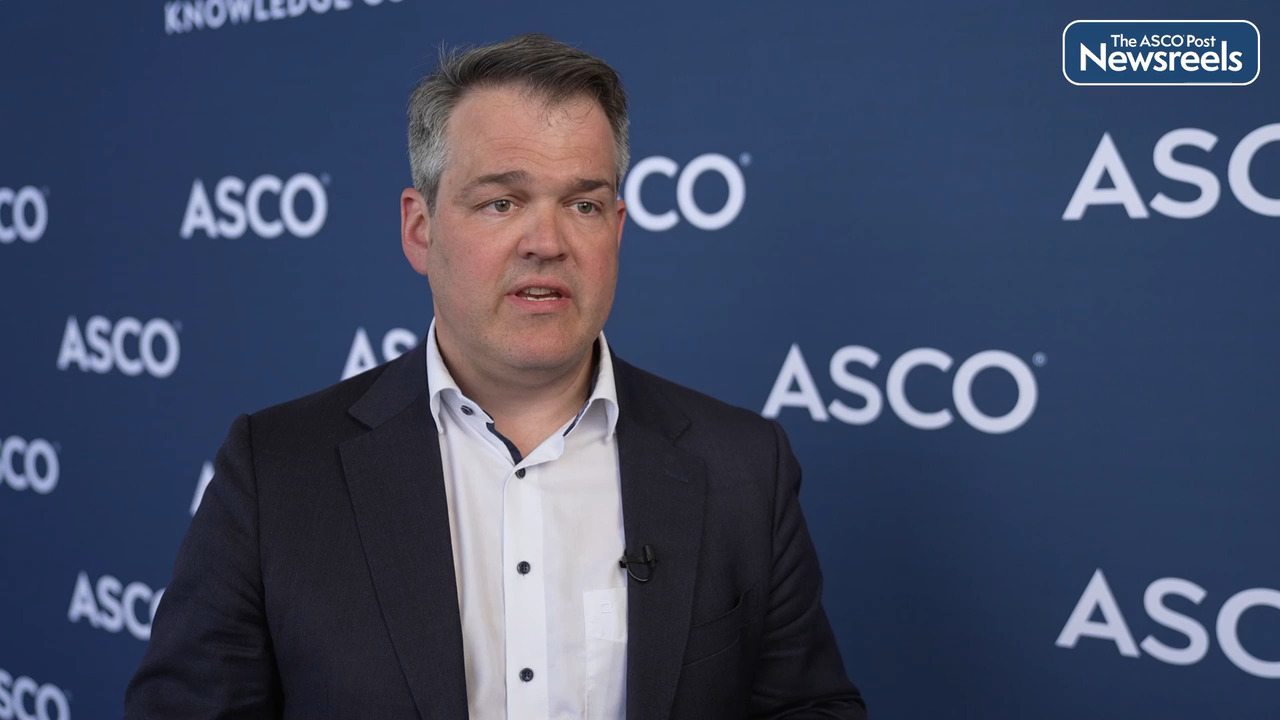Transcript
Disclaimer: This video transcript has not been proofread or edited and may contain errors.
Narjust Florez:
You presented a practice changing study, KEYNOTE-671. We're going to ask you to quickly summarize the design of the study for us.
Heather A. Wakelee:
So KEYNOTE-671 was looking at perioperative pembrolizumab, which was pembrolizumab versus placebo given with cisplatin-based chemotherapy for four cycles, then going to surgery and then going to adjuvant pembrolizumab or placebo.
Narjust Florez:
So this is different to something we know. We are doing a little bit of a sandwich effect. We're doing neoadjuvant and then adjuvant pembrolizumab, correct?
Heather A. Wakelee:
That's correct. So this perioperative approach is really hitting a lot of round here in non-small cell lung cancer early stage, where we've now had three trials with similar designs with readouts in the last few months and more trials coming.
Narjust Florez:
So to summarize some of the main results of the study for us.
Heather A. Wakelee:
So this study was for patients with stage 2 and 3 non-small cell lung cancer, and it had a dual primary endpoint. So with either being positive, positive trial at this time we had our first interim analysis and our event-free survival hazard ratio was 0.58, which was highly statistically significant. Overall survival, we haven't had enough events at this time to call anything statistically, but the trend was looking very favorable.
Narjust Florez:
So the difference with this is also that now we have the opportunity to get therapy after the surgery, correct?
Heather A. Wakelee:
That's correct. Or you could look at it the other way. We have an opportunity to give it before because we already have adjuvant, two options approved, and neoadjuvant, one option approved in combination with chemo. So this is combining both of those strategies.
Narjust Florez:
Was there any particular subgroup that benefit more compared to the other patients in the study?
Heather A. Wakelee:
What was nice about this trial is when we looked at all of the different subsets, we actually saw benefit across all. Now, there were some subtle differences. If you look by stage the patients with stage 2 versus stage 3, the patients with stage 2 still had a positive event-free survival hazard ratio 0.65, but the 95% confidence interval was 1.01. So it wasn't fully significant. You have to be careful. Of course in subsets we don't powered for every single one, whereas the stage 3 was more in the 0.5 range, so it was a little bit better.
The other difference, and this is one that comes up a lot, is this question about PD-L1. So in this trial we had about a third of patients with no PD-L1 expression, about a third of 1 to 49%, a third with greater than 50% PD-L1 expression. And in the group that had the highest PD-L1 expression, we did see a more favorable event-free survival hazard ratio closer to 0.43, 0.421, 0.43. It was about the same actually in the 1 to 49.
And then when we got to the less than 1%, it wasn't quite as positive. It was 0.77 and that 95% confidence interval did cross one. But it was still, the trend was very firmly in the benefit side. And again, too many subsets. We have to be very careful not to look at that. But given some of the other data that's been shown with other trials, other drugs in the adjuvant and neoadjuvant setting, seeing that still very strong trend even in those without PD-L1 expression was very comforting to me and also very comforting to see that highest PD-L1 highest benefit, which is what we've seen across most trials. So not everyone.
Narjust Florez:
And I think something important about these trials, the early stage, it takes longer, right? Compared to some of the data we know about metastatic disease. So I think the story about KEYNOTE-671 will continue. This is just the first chapter. A question that I think the surgeons that listens to us we have is these approach affect at all patients get into surgery?
Heather A. Wakelee:
That's a very good question. So one of the debates that comes up is when you look at all of the trials that have a neoadjuvant component, there are patients who don't make it to surgery. And so in this trial it was similar to many of the others. So somewhere 15% to 20% we were close to that. And from a surgical perspective, the surgeons are going to say, "Well, that means that some patients never get to surgery, who would've?" But the other way of looking at it is the fact that many of these patients being considered for these trials that involve neoadjuvant are patients who wouldn't otherwise be considered for surgery.
So I'm not sure that we're really excluding that many patients from surgery. We didn't have very many who progressed and couldn't go to surgery, though there were many who decided not to go to surgery for other reasons. So we have to be cautious and I think when we take this, "What does it mean in the big picture?" Well, we know for patients with stage 3, patients with stage 3 disease need some sort of systemic therapy, we really don't cure very many of them without that. And so from my perspective, if the patient has stage 3 disease, they really should be getting a neoadjuvant approach. And that was pretty much a standard even with chemo though not always seen.
For stage 2, I think we have some room to discuss and really every patient that we're going to be considering for this sort of an approach should be seen in a multidisciplinary tumor board before treatment is started. And a tumor board that includes surgeons and radiation oncologists and medical oncologists and others so that we can really together and in discussion with a patient decide what's the right approach for them. Should we be aiming for surgery? Or is this someone who could be cured with a definitive radiation approach for stage 3? Or is it someone who really should just go to surgery first and then decide on what's found definitively at that time if they need additional treatment or not? So that might be some of our stage 2 patients.
Narjust Florez:
And that's an excellent point because with the introduction on neoadjuvant therapy, multidisciplinary care is essential. We cannot do this in little asylums. We need to work together.
So as you present the results, a lot of our colleagues in the community are caring for our patients right now. How will you quickly summarize the results in a practical way to our community oncologists?
Heather A. Wakelee:
So I think KEYNOTE-671 is showing us that we have another option for treating our patients with stage 2 and 3 and that this consideration of chemotherapy plus pembrolizumab followed by surgery, followed by pembrolizumab is a reasonable approach. Again, we don't have FDA approval yet for that neoadjuvant piece, so I don't want to say that too strongly, but we do really need to emphasize the importance of that multidisciplinary discussion. And that should be done even in any community setting. You're going to be working with radiation oncology surgeons, so some way to discuss these patients before treatment is started and we should do some testing.
Narjust Florez:
Yes.
Heather A. Wakelee:
So we need to do testing for EGFR and ALK. We had a small subset of those patients in this trial too small to really say anything definitively, but in other trials they've been excluded and we've seen very positive results, at least from the setting of EGFR with adjuvant osimertinib.
So we have other options if we're finding driver mutations where we feel like maybe immune therapy is not the best approach. Sp we need to know what's going on from a driver mutation perspective. And I think knowing the PD-L1 level is helpful and these are things that can be done relatively quickly while you're still deciding surgery, radiation for a stage 3 patient.
Then moving forward, if it's a patient who we feel like, "Okay, this is a patient who's going to benefit from systemic therapy." This concept of up to four cycles, cisplatin-based chemotherapy plus pembrolizumab with surgical resection, we know that more patients were able to have a complete resection and do well with their surgery. And then followed by that adjuvant piece with pembrolizumab, that's led to this event free survival hazard ratio 0.58 when we look at all comers and in an all comer situation that's better than we've seen in most of the other studies. So it's very exciting and the fact that the subset sort of fit right higher PD-L1 more benefit, stage 3 more benefit. So from that perspective, that was a very exciting study.
Narjust Florez:
That's a very good point. We don't have to wait for the surgical tissue. We have to test a diagnosis for biomarker and PD-L1. My last question to you, doctor, is do you share your results, we patients and families?
Heather A. Wakelee:
That's a wonderful question. I mean for the scientific community, we now have a publication in New England Journal Medicine, so it's out there for everyone to read. But when I'm meeting with a patient and their family, again, I would really like to have that be as part of a multidisciplinary tumor board. And we meet every week with our surgeons radiation oncologists to discuss any cases that any of us have seen. So if someone comes in first to radiation, first to surgery, first to medical oncology, we present and discuss to kind of come up with that strategy.
Then meeting with the patient. We'll talk about, sometimes we think about radiation or surgery and if we're thinking about surgery, we know that's not usually enough and now there's definitive data from several trials. And if we give chemotherapy plus immune therapy before surgery, so mean they don't have a driver mutation, that that's going to increase the probability that they're going to be able to get to the surgery and then much higher likelihood that they're going to have a longer time period before their cancer may or may not come back. And we're hoping it's going to improve survival that we can't say that definitively yet.
And then go through what does that look like? What does four cycles of chemotherapy plus immune therapy look like? What are some of the side effects that we might have to be aware of? What is surgery like? And then what does it mean to come in for another year of ongoing therapy? To kind of weigh for them those quality of life issues, but how does that fit into this really significant improvement and event increased survival with that being a composite endpoint of events that precluded going to surgery as well as evidence of recurrence or overall survival changes.
Narjust Florez:
So thank you so much, doctor. This is practice changing. I can't wait to go back to clinic. And also I think there was a very good question to ask because with neoadjuvant we are like, "So what is next?" So now we have more data about that. Thank you for your time and congratulations.
Heather A. Wakelee:
Thank you.





